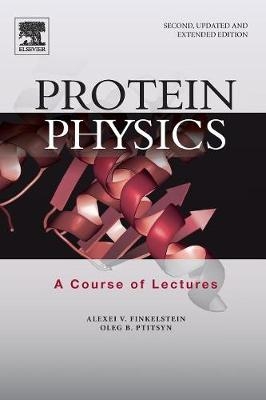
Protein Physics
Academic Press Inc (Verlag)
978-0-12-809676-5 (ISBN)
The book systematically summarizes and presents the results of several decades of worldwide fundamental research on protein physics, structure, and folding, describing many physical models that help readers make estimates and predictions of physical processes that occur in proteins.
New to this revised edition is the inclusion of novel information on amyloid aggregation, natively disordered proteins, protein folding in vivo, protein motors, misfolding, chameleon proteins, advances in protein engineering & design, and advances in the modeling of protein folding.
Further, the book provides problems with solutions, many new and updated references, and physical and mathematical appendices. In addition, new figures (including stereo drawings, with a special appendix showing how to use them) are added, making this an ideal resource for graduate and advanced undergraduate students and researchers in academia in the fields of biophysics, physics, biochemistry, biologists, biotechnology, and chemistry.
Alexei V. Finkelstein is the Head of the Laboratory of Protein Physics at the Institute of Protein Research, Russian Academy of Sciences. He is also a Full Professor in Biophysics at the Pushchino Department of the Lomonosov Moscow State University. He won the National Prize of Russia in Science in 1999 and is a Howard Hughes Medical Institute International Research Scholar. He is the author of about 150 papers on protein physics.Oleg B. Ptitsyn (deceased 1999) was the Head of Protein Physics Laboratory at the Institute of Protein Research, Russian Academy of Sciences and a Visiting Scientist at the Laboratory of Experimental and Computational Biology, Molecular Structure Section, National Cancer Institute, USA. He was also a member of the European Academy of Sciences and winner of the National Prize of Russia in Science (1999). He authored about 250 papers on polymer and protein physics.Their laboratory is one of the most distinguished in the world for its work in protein physics. It is one of the few laboratories outside the USA to receive support from the Howard Hughes Medical Institute. Both scientists have very high international reputations, Professor Finkelstein is frequently invited to conferences in Europe and in the USA, as was Professor Ptitsyn before his recent death.
Part I INTRODUCTIONLecture 1: Main functions of proteinsPart II ELEMENTARY INTERACTIONS IN AND AROUND PROTEINSLecture 2: Amino acid residues in proteinsLecture 3: Quantum mechanics, Pauli exclusion principle, and non-covalent interactionsLecture 4: Influence of water environmentLecture 5: Water, hydrophobicity and proteinsLecture 6: Influence of an aqueous environment on electrostatic interactionsPart III SECONDARY STRUCTURES OF POLYPEPTIDE CHAINSLecture 7: Secondary structure of polypeptidesLecture 8: Elements of statistical mechanicsLecture 9: Free energy of initiation and elongation of a-helices in a homopolypeptideLecture 10: 20 + 2 + 1 gene-coded amino acids in proteinsPart IV PROTEIN STRUCTURESLecture 11: Fibrous proteins, their functions, their regular primary and secondary structuresLecture 12: Membrane proteins; peculiarities of their structure and functionLecture 13: Globular proteinsLecture 14: Structure of a-proteinsLecture 15: Classification of protein foldsLecture 16: What secondary structure can be expected for random and quasi-random amino acid sequencesPart V COOPERATIVE TRANSITIONS IN PROTEIN MOLECULESLecture 17: "Well-folded" and "natively disordered" (or "intrinsically disordered") proteinsLecture 18: Denaturation of globular protein: why is it an "all-or-none" transitionLecture 19: Protein folding in vivo and in vitroLecture 20: Two-state folding of small proteins: kinetic analog of the thermodynamic "all-or-none" transitionLecture 21: Solution of "Levinthal paradox"Part VI PREDICTION AND DESIGN OF PROTEIN STRUCTURELecture 22: Protein structure prediction from amino acid sequencesLecture 23: Overview of approaches to prediction and recognition of tertiary structures of proteins from their amino acid sequencesPart VII PHYSICAL BACKGROUND OF PROTEIN FUNCTIONSLecture 24: Protein function and protein structureLecture 25: Combination of elementary functionsAppendix A.: Theory of coil-globule transitions in homopolymersAppendix B.: Theory of helix-coil transitions in homopolymers Appendix C.: Statistical physics of one-dimensional systems and dynamic programmingAppendix D.: Random energy model and energy gap in the random energy modelAppendix E.: How to use stereo drawingsProblems & Solutions
| Erscheinungsdatum | 02.07.2016 |
|---|---|
| Verlagsort | San Diego |
| Sprache | englisch |
| Maße | 152 x 229 mm |
| Gewicht | 1080 g |
| Themenwelt | Naturwissenschaften ► Biologie ► Biochemie |
| Naturwissenschaften ► Physik / Astronomie ► Angewandte Physik | |
| Naturwissenschaften ► Physik / Astronomie ► Atom- / Kern- / Molekularphysik | |
| ISBN-10 | 0-12-809676-4 / 0128096764 |
| ISBN-13 | 978-0-12-809676-5 / 9780128096765 |
| Zustand | Neuware |
| Haben Sie eine Frage zum Produkt? |
aus dem Bereich


